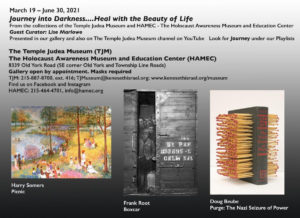
#72 ~ EXHIBITION ANNOUNCEMENT: March 19 – extended until July 9, 2021
Journey into Darkness….Heal with the Beauty of Life
From the collections of the Temple Judea Museum and HAMEC* – The Holocaust Awareness Museum and Education Center
Guest Curator: Lise Marlowe
NOTE: Portions of the exhibition are available on YouTube at Temple Judea Museum. Choose the Play List: Journey into Darkness
BACKGROUND INFORMATION: HAMEC exhibited paintings by the late Harry Somers and sculptural reliefs by the late Frank Root. TJM is exhibiting objects from its collection of Holocaust and Acts of Oppression and Resistance.
- HAMEC
Guest Curator, LISE MARLOWE, a teacher at Elkins Park Middle School, who won the History Channel’s teacher of the year award in 2006, is largely responsible for the idea for this joint exhibition. She is active with HAMEC and is also a KI member, and former KI teacher.
“Frank Root’s wife contacted me after seeing the Philadelphia Inquirer story featuring the Harry Somers’ project I did with my Elkins Park students. She invited me to her home to see Frank’s work and I was moved beyond tears. I said we need to make sure students see this work and the way it portrays the Holocaust. By just looking at the art, students understand the horror. Frank’s work is so powerful and a very important educational tool.
The idea for this exhibition came to me from the impact I witnessed among my students when they saw Frank’s work and heard Harry’s story. I wanted the community beyond our school to experience the same power of art as a component of Holocaust Education. I feel seeing the darkness of Frank’s relief work and then showing the beauty of Harry’s paintings is inspiring and memorable. If we give everyone the opportunity to experience Holocaust education with art, artifacts and survivor testimonies, then we can have a brighter future for all. The title of the exhibition reflects my hopes.” Lise Marlowe, 2021
Opened in 1961, HAMEC*, the first Holocaust Museum in the United States, educates students and adults, personalizing the Holocaust so that they learn the consequences of racism, ethnic cleansing, and intolerance. A variety of Holocaust awareness programs are offered, including eyewitness testimonies, personal interactions with eyewitnesses, two live theater performances, and docent-led tours.
- The Temple Judea Museum (TJM)
Many of the objects in the TJM Collection of the Holocaust and Acts of Oppression and Resistance represent a unique perspective of lives that were directly or indirectly affected by the Holocaust. In addition, through press photographs taken during and after WWII, and with the addition of the gift of the Alvin Gilens’ Photograph Collection, TJM is able to document through rare, original images, the plight of Jewish victims and refugees during the war and, later, during resettlement. This collection also contains contemporary art work by artists such as Kezia Lechner, Doug Beube, Mary Costanza, Robbin Ami Silberberg and Alvin Gilens. Selected objects from the larger collection are displayed in this exhibition.
Rita Rosen Poley, TJM Director and Curator: “TJM is happy to be able to welcome this collaborative exhibition into its gallery and looks forward to more exchanges with HAMEC. There is no doubt that art touches the soul and that there is no better purpose than to use art to teach the history and horrors of the Holocaust and the hope for a future without war and oppression.”
ATTACHMENTS:
Videos (above) & Images (below) from the exhibition
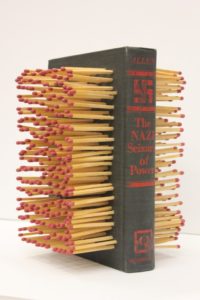
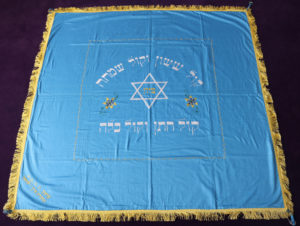
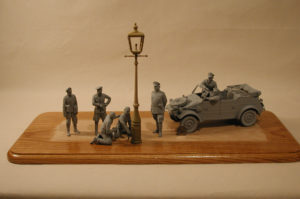
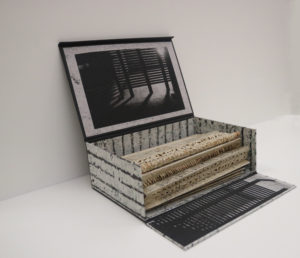
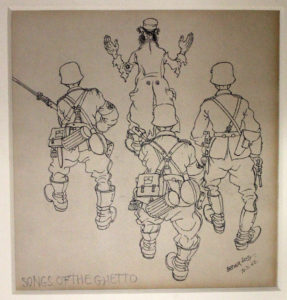
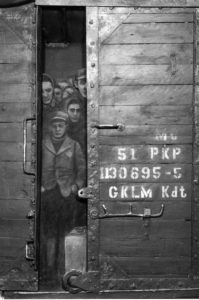
SUPPLEMENTAL INFORMATION:
- Exhibited Objects Related to the Holocaust and Acts of Oppression and Resistance in the Permanent Collection of the Temple Judea Museum: (SEE ATTACHMENT)
- EXPERIENCING “JOURNEY INTO DARKNESS, HEAL WITH THE BEAUTY OF LIFE” by Rabbi Lance J. Sussman, Ph.D.
GREETING FROM HAMEC’S PRESIDENT:
On behalf of the Board of Directors and the professional staff of the Holocaust Awareness Museum and Education Center (HAMEC) I share our pride and pleasure in partnering with the Temple Judea Museum to present this special exhibition, Journey into Darkness….Heal with the Beauty of Life. This project is another way in which HAMEC is carrying out our mission to educate students and adults in the Philadelphia area and around the world, personalizing the Holocaust so that they learn the consequences of racism, ethnic cleansing, and intolerance. The HAMEC leadership team is pleased to have relocated our base of operations to Reform Congregation Keneseth Israel in August of 2020. We look forward to doing more collaborative work with the congregation and the museum in the future. Chuck Feldman, HAMEC President
HAMEC, opened in 1961, was founded by Holocaust survivor Jacob Riz and is the first Holocaust Museum to open to the public in the United States. A variety of Holocaust awareness programs are offered, including eyewitness testimonies, personal interactions with eyewitnesses and their descendants, also docent-led tours of exhibited artifacts related directly to eyewitness accounts. Programs are conducted in person and virtually.
- Works by Frank Root and Harry Somers are provided by HAMEC
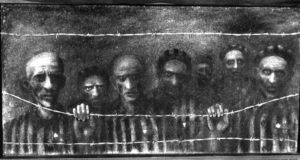
FRANK ROOT (1936 – 2015) After serving in the Korean War he eventually became involved in window display. After a period of apprenticeship at the Blum Store he went on to become a highly respected display director specializing in fine jewelry displays for Bailey, Banks and Biddle and the J.E. Caldwell Company where his miniaturized windows became part of the joy of shopping on Chestnut Street. He won many awards including a study trip to Geneva with the Rolex Watch Company where he served as visual merchandising consultant to Rolex. He also won frequent awards and commendations from the display industry. While at Caldwell’s he was commissioned by Dr. Evan Turner, director of the Philadelphia Museum of Art, to design a Crystal Ball for the museum. He eventually started his own display company which grew to include many of the specialty shops on Chestnut and Walnut Streets.
In 1976, at age 40, after open heart surgery, his work took a different turn, into the fine arts. His important and well-respected “Holocaust Series”, parts of which are displayed here, is a result of that transition. The series began as a single memorial piece in memory of his mother-in-law, Sadie Silverman. Homasote surfaces are drawn, carved, assembled and again drawn upon with black and white pastel to create a relief image that is at once both actually three-dimensional and deeply trompe l’oeil (Fool the eye).
As he became more involved and dedicated to conveying the powerful messages of the Series, he also became more engrossed with the personal challenge of developing this self-designed medium. It is his almost clinical attention to detail and authenticity that make his work approachable and compelling despite its horrific content. There is not the sense that the images are exaggerated or sensationalized in any way. They are stated as clearly and succinctly as possible without color.
Frank Root developed media from unlikely sources. From his one-way mirror stabiles of the 1960s, to his vinyl covered portraits of the 1970s, to the graphite and homasote drawings and mixed media assemblages of the 1980s, he turned homasote into a surface for pure relief drawing. (Homasote is a recycled paper board usually used for building construction). He carved, manipulated and refined the rough surface of the homasote, adding black and white pastel, to produce visual surfaces evocative of the heaviness of eroded concrete and old wooden beams, slats and brick walls, yet delicate enough to express the fragility of the human body or of pleading eyes. By applying this technical concept of spatial illusion that had been intriguing him for several years, medium and message have coalesced in Root’s starkly moving, “Holocaust Series”. (Excerpted from the artist’s biography)
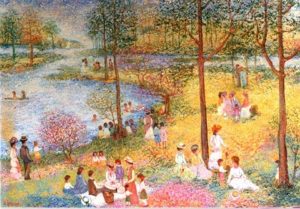
HARRY SOMERS (1936 – 2013)
Local teacher, Lise Marlowe, the History Channel’s Teacher of the Year in 2006, was scouring online sources in 2007 in search of fresh ways to teach her multi-cultural sixth graders about the Holocaust. She stumbled on a brief trailer for a film about Harry Somers, a German Jewish post-Impressionist painter who, as a teen, fled the Nazis via a Kindertransport rescue to England. When Somers was just 16, he began a new life, passing through England to Australia. At 20, he joined the Australian Army, where a fellow soldier introduced him to the art of painting. Later, in New York City, he began exhibiting and selling his work. But the memories of his harrowing ordeal were always close to the surface. It became Somers’ mission to respond to the hate he had experienced by making art infused with beauty, color, and peace. Painting became his escape, a way to cope with the loss of his family and the trauma of surviving Nazi Germany. His paintings have been described as “luminous,” “glowing” and “alive.” Somers’ paintings typically represent landscapes inhabited by people enjoying each other’s company. Moreover, his work is a profound contrast to the darkness and despair that so characterized the Holocaust.
After discovering Somer’s work, Marlowe was in touch with the film’s producers who put her in touch with Somers’ widow, Joyce, who was so pleased to make the connection that she sent two signed and numbered prints of her late husband’s work to the school. That’s when Marlowe decided to turn this serendipity into a lesson: Using transcripts from the filmmaker’s hours of interviews, she drafted a kid-friendly version of Somers’ story. Her students viewed Somers’ paintings online and wrote poems in response. In honor of Yom HaShoah/Holocaust Remembrance Day, the students and their teacher toured local bookstores, sharing the paperback they created, “Bringing Beauty into the World: The Life of Harry Somers.” (Excerpted from an online article)
The Temple Judea Museum
Director/Curator: Rita Rosen Poley Chair: Karen Shain Schloss
Friends’ Chair: Norma Meshkov Chair, TJM Artists’ Collaborative: Marlene D’Orazio Adler
215-887-8700, ext. 416; TJMuseum@kenesethisrael.org; www.kenesethisrael.org/museum
Hours: By appointment, Masks must be worn An accessible facility,
Visit us on YouTube at Temple Judea Museum and on Facebook and Instagram
See portions of our collection at Temple Judea Museum online collections
A Program Stream awardee of the Pennsylvania Council on the Arts
